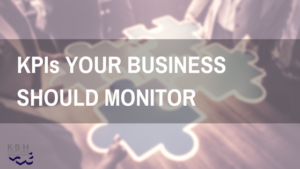Running a business often entails a deep focus on what you’re making, what you’re spending and how much is left over. These financial key performance indicators (KPIs) are important, and when they are viewed independently they tell one piece of the story. However, when you put them all together that’s when you are truly able to understand how your business is operating.
In order to maintain a successful business you need to understand not only what the financial KPIs are, but also realize how they are connected to your business’ overall financial well-being. With that being said, it’s important to note that the majority of KPIs are industry specific. Therefore, it is not possible to cover off every option. For example, one business’ gross margin percentage might be higher than others – a retail store will have higher margins than a construction business for the simple reason of the difference of cost in materials.
Some KPIs that can apply to most businesses include:
- Working Capital: Is the basic measure of a business’ financial strength. This is calculated by subtracting the company’s current assets and current liabilities.
- Current Ratio: This is a liquidity ratio which helps business owners measure their ability to pay both short-term and long-term debts by considering the business’ current total assets and the current total liabilities. This is calculated by dividing the business’ assets by the liabilities. Any ratio under 1 indicates that the liabilities are greater than the overall assets, therefore indicting that the business is not in good financial health as they would be unable to pay off debts if they became due.Usually retail companies have ratios lower than 1 because of their business model which offers shorter credit periods to their customers.
- Return on Equity: Is the amount of net income returned as a percentage of the shareholders equity and measures a business’ profitability through revealing how much profit is generated with the funds invested by shareholders. This is represented as a percentage and is calculated by dividing net income from the shareholder’s equity (not including preferred shares).
- Debt to Equity: This is another leverage ratio that compares a company’s total liabilities to its total shareholders’ equity. It is a measurement of the percentage of the company’s balance sheet that is financed by suppliers, lenders, creditors and obligors vs. what the shareholders have committed. The ratio is calculated by dividing the company’s total liabilities by its shareholders’ equity.What’s important to know is that this ratio is not a pure measurement of a business’ debt as it includes operational liabilities as a part of the total liabilities used in the calculation.Furthermore, what constitutes a “good” or “bad” ratio varies by industry. For example, the telecommunications or IT industry often require up-front and frequent ongoing capital investment(s); which are often financed via loans meaning their debt to equity ratio would be higher.
- Accounts Payable Turnover: Is a short-term liquidity measure used to quantify the rate at which a company pays off its suppliers and is calculated by taking the total purchases made from suppliers, or cost of sales, and dividing it by the average accounts payable amount during the same period. This can be used to show investors how many times per period the business pays its accounts payable.
- Accounts Receivable Turnover: Is a widely used measure for analyzing how efficiently a business is managing their current assets, and is calculated by dividing sales by accounts receivable. This number is a measure of how efficiently a business is able to collect on the credit it extends to customers – net 30 payments, overdue payments, etc.If your business is good at collecting the credit then the ratio will appear lower ratio. Many businesses, such as restaurants or smaller retailers often use this to compare themselves with others in the same industry.
- Inventory Turnover: This is often used in tandem with accounts receivable turnover, and is a ratio that shows how many times a business has sold and replaced inventory during a specific period of time (or quarter). A business can calculate this by dividing sales from the average inventory and allows them to compare it to industry averages.Low turnover implies weak sales and excess inventory, while a high ratio implies either strong sales or large discounts.
If you are ever unsure, or struggle with running your business KBH is here to help with services that can be tailored to suit your specific business needs. Contact us to find out more about our Outsourced Accounting Services: info@kbh.ca
